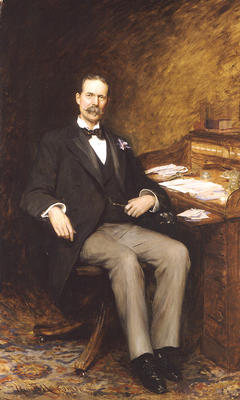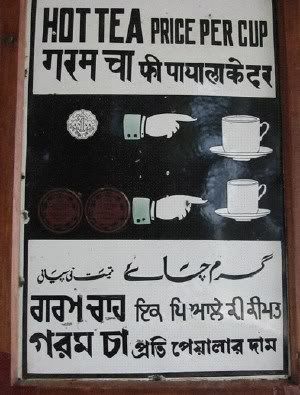I am sitting in front of my computer, listening to my favorite “Vital Signs” song:
Ye shaam phir nahi aaye gi
(This evening won’t come again)
I am smiling and sipping on my favorite Lipton Tea, while my fingers are keying in this moment in time.
All in all, a very coordinated effort is going on between my mind and soul. But take “Lipton tea” out of this equation and I’ll be left to a bored-to-death person listening to an archaic ancient group which historians remember by the name of ‘Vital Signs’ from early 90s and writing these disjointed words.
“Lipton Tea” – these two words stir deep memories in me. The earliest memory of Lipton tea in my life is drinking it with my maternal great grandfather (paR-nana).
 This portrait to the left, by the way, is of Sir Thomas J Lipton; not of my paR-nana!).
This portrait to the left, by the way, is of Sir Thomas J Lipton; not of my paR-nana!).
My great grand father was born in 1896 and lived till 1986. Until his last days he had a habit of making a cup of tea around 3 pm, and whenever I was around (which I always was) he used to pour some tea in my cup too. After that both of us would start watching PTV which started its daily transmission around 4 p.m. and sip on our tea.
Grandfather had migrated to Pakistan from India in 1947. He used to tell me all these great political stories from the old days, the Caliphate Movement, First World War, Quit-India Movement, Second World War, the Pakistan movement and finally the emergence of Pakistan.
He told me that until 1900s not many people in India knew about drinking tea (except for the tea growing areas of Darjeeling/Assam etc). British and whatever was left of East India Company at that time owned all the tea plantations in India, Ceylon (SriLanka), and Africa. Raw tea leaves were sent to London at Lipton Tea Company and after being processed and packed, was brought back to India and sold at exorbitant prices to the local people, on whose land the tea grew in first place.
Grand father told me that in the early 1900s Britishers used to set tea-stalls at street corners all over India and used to offer ‘free’ tea cups to Indians to promote the Lipton brand. In the beginning tea drinking was fashion at the high echelons of Indian society. Nawabs, and Rajas used to drink it in parties but within years its use grew all around and it even reached the far-flung villages of India.
 The accompanying picture to the right is a tablet that was placed at Bahawalnagar railway station in early 20th century. It is now placed in Pakistan Railway’s Heritage Museum at Golra Sharif near Islamabad. It advertises making of hot tea in 5 different written scripts; English, Devnagri, Urdu, Gormukhi and Bengali.
The accompanying picture to the right is a tablet that was placed at Bahawalnagar railway station in early 20th century. It is now placed in Pakistan Railway’s Heritage Museum at Golra Sharif near Islamabad. It advertises making of hot tea in 5 different written scripts; English, Devnagri, Urdu, Gormukhi and Bengali.
Grand father told me that drinking tea at 3:00 p.m. sharp was a British tradition brought to India. British used to drink tea two times a day en-mass. First time was at 3:00 p.m. (called ‘low tea’) and then again at 6:00 p.m. (called ‘high tea’). Low tea and high tea were the names given to this tea drinking habit just like breakfast-lunch-dinner.
The invention of the habit of afternoon tea is credited to Anna, Duchess of Bedford, who in about 1840 began taking tea with sandwiches and cakes to ward off “that sinking feeling” around four o’clock in the afternoon. Since the upper classes ate dinner fashionably late, Anna and her friends found that tea and small cakes were perfect to tide them over between lunch and dinner. Her idea soon became the fashion, and an English institution was born called ‘low tea’.
I guess grandfather and I kept the tradition alive in Karachi till 1986.
Last time I was in Pakistan I saw tea stalls and tea-shops at almost every street corner. It looks like the whole population now craves tea. And it is a part of our daily life. I won’t say its addiction, but would rather recite the famous sher by plagiarizing it a bit:
Chai se gharz-e-Nishat hai kis roo-siaah ko
Ik gona-e-bay-khudi mujhay har dum chahiyay
(Who the cursed-face needs pleasure out of tea
All I need is a place of solitude.)
Tea is also an essential part of Urdu literature. Shafiq-ur-Rehman who along with Mushtaq Ahmed Yousufi is perhaps the greatest humor writer of Urdu invented the term chuhaas which rhymes with pyaas(thirst) and means a thirst of tea.




















































Some comments from the ATP Facebook Page:
– “Greatest Marketing Feat of the British in this region to have people who used to drink Lassi, lemonades, sattu etc in a HOT region and to addict them to a drink that in totality is wrong for our type of environment.”
– “very nice writeup. And agree with Shehzad, this was teh marketing campaign of all times!”
– “Couldn’t agree more!”
– “tea is addictive wether we admit it or not.but is not prohibited. so jis ne tea pini he piye, jis ne nahin pini na piye.”
– “Lipton, Kenya etc all all British owned companies and while we drink tea, Britain still gets rich. Indo-Pak sub-continent remains the largest tea consumers in the world.”
– “Addiction to any thing in Islam is prohabited. I love to drink it in winters it helps a lit to make u warm but in summer and spring I avoid it zero percent taking. I also try to avoid it for making my self active and awake as I beleive the fulfillment of proper sleeping hours can make you more active then adopting the official way. Tea with different flavors is also more delicious.”
– “medically there is a difference between habit and addiction . you can give up your habit and it will not effect you physically or neurologically . you might feel tired for one day or two three days but you will get rid of the habit by the fourth one and you wont even need it . addiction of alcohol or other drugs effects you the minute you start taking them plus the withdrawal is a menace itself. but then again tea has caffeine . a mild diuretic so yeah it has its disadvantage of dehydration… anyways good job mister author! i really enjoyed reading”
– “an out of control habbit is an addiction itself…..ask any tea lover who takes more than 8 cups a day, what withdrawl symptoms are”
– “I hate the teraditional milk tea. takes all the taste out of it. and its bad for health. so drink tea widout milk. spread the awarness”
What a wonderful write up and great memories. Yes, Chai has become so speical in or lives
Reading this post while sippping lipton tea.
Yeh shaam and chai chahie – kya combination hai.Bas sardion ki kami hai.
Chai Chahiya, Kon Si Janaab?
Lipton Unda hay, Lipton Leejeeay
I think we all have fond memories of Lipton Chai and a great association with ‘Chai’ itself. I like your write up and enjoyed looking at the images of tea drinking. It reminds us the good old days when we had East Pakistan.
Best,
Zahra
Yeh shaam phir nahi aey gi…Mughal sahab.